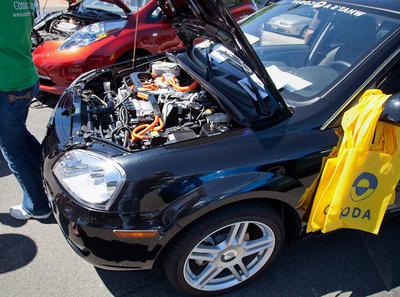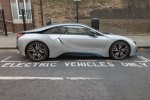High Voltage Wire Gauge Size for Electric Car
by Ron
(Toronto)

Photo by Robert Couse-Baker
What type of wire is required or recommended for the primary power from the battery to the controller -then to the motor?
must it be shielded?
does it have to be international orange?
will welding wire do?
Hi, Ron -
Looking at the price difference between welding cable (1.50/ft) and EV cable (5.25/ft) you might be quite reasonably questioning why you should spend the big bucks for what is basically the same thing! Right?
First, I have to say that folks have wired their electric vehicle conversions with all kinds of cables they thought would work or that they had on hand, so nobody is stopping you, but there's a pretty good reason some cables are recommended and others are not.
There's also a really good reason for international orange!: )
The difference between the welding cable and the electric car cable is: the welding cable is insulated for up to 90 degrees where the EV cable is insulated for up to 220 degrees.
The EV cable is shielded to cut down on EMI (electromagnetic interference) and RFI (radio frequency interference) noise and insulated to prevent stray currents from corroding your wire.
The welding cable seems to have been developed for maximum flexibility, where the EV cable was apparently developed for maximum ruggedness.
You'll appreciate all those expensive EV cable qualities the first time you really put your foot into the accelerator to get up to speed on the freeway. You're sucking a lot of amps right then and generating heat through the wires.
Wire gauge, you probably already know, is measured in zeros. Weirdly. Your electric vehicle conversion's high voltage cables will generally be either 1/0 (one ought) or 2/0 (two ought). 2/0 is thicker wire than 1/0, so less heat.
One ought NOT go any thinner than those for the high voltage stuff. (See what I did there, lol.)
If I'm understanding the bewildering world of wiring sizing and naming correctly...
4 AWG is the thinnest, then
3 AWG
2 AWG
1 AWG...
then
O AWG (1/0),
00 AWG (or 2/0)
000 AWG (3/0), and then
0000 AWG (4/0) is the thickest.
I guess I'd want to put 2/0 wire where I had to have current traveling longer distances, if it wasn't clear which gauge wire I'd need, because heat increases over distance the current is carried; the culprit is the resistance in the copper wiring. More distance, more resistance.
About that International Orange: well, it's not pretty, I agree. It's the international standard for high voltage wiring, and it's done to keep first responders like paramedics safe in case they have to, you know, cut you out of your car or whatnot. (Heaven forbid.) Not everybody uses it, but I wish they would.
Hope this helps.
Regards,
Lynne
Comments for High Voltage Wire Gauge Size for Electric Car
|
||
|
||

